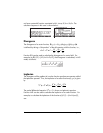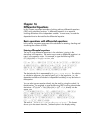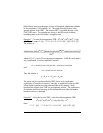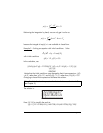
Page 16-5
Both of these inputs must be given in terms of the default independent variable
for the calculator’s CAS (typically ‘X’). The output from the function is the
general solution of the ODE. The function LDEC is available through in the
CALC/DIFF menu. The examples are shown in the RPN mode, however,
translating them to the ALG mode is straightforward.
Example 1
– To solve the homogeneous ODE: d
3
y/dx
3
-4⋅(d
2
y/dx
2
)-11⋅(dy/
dx)+30⋅y = 0, enter: 0 ` 'X^3-4*X^2-11*X+30' ` LDEC μ.
The solution is:
where cC0, cC1, and cC2 are constants of integration. While this result seems
very complicated, it can be simplified if we take
K1 = (10*cC0-(7+cC1-cC2))/40, K2 = -(6*cC0-(cC1+cC2))/24,
and
K3 = (15*cC0+(2*cC1-cC2))/15.
Then, the solution is
y = K
1
⋅e
–3x
+ K
2
⋅e
5x
+ K
3
⋅e
2x
.
The reason why the result provided by LDEC shows such complicated
combination of constants is because, internally, to produce the solution, LDEC
utilizes Laplace transforms (to be presented later in this chapter), which
transform the solution of an ODE into an algebraic solution. The combination
of constants result from factoring out the exponential terms after the Laplace
transform solution is obtained.
Example 2
– Using the function LDEC, solve the non-homogeneous ODE:
d
3
y/dx
3
-4⋅(d
2
y/dx
2
)-11⋅(dy/dx)+30⋅y = x
2
.
Enter:
'X^2' ` 'X^3-4*X^2-11*X+30' ` LDEC μ


















